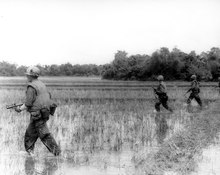Operation Union II
| Operation Union II | |
|---|---|
| Part of Quang Tin provinces, South Vietnam | |
| Result | U.S./South Vietnamese claim victory |
23 captured
Operation Union II was a
Background
The Quế Sơn Valley is located along the border of
During Operation Union from 21 April to 16 May, the 3rd Battalion, 1st Marines had fought the PAVN 21st Regiment near the Marine outpost on Loc Son Mountain for control of the southern part of the Quế Sơn Valley. Operation Union II was launched on 26 May to destroy the withdrawing remnants of the PAVN with a helicopter assault by the 5th Marine Regiment, commanded by Colonel Kenneth J. Houghton. The assault was coordinated with ground attacks by the ARVN 6th Regiment, 2nd Division and the 1st Ranger Group.
Prelude
The plan called for 1/5 Marines, commanded by Lieutenant Colonel Hilgartner, to establish blocking positions in the western portion of the valley while the 3/5 Marines, commanded by Lieutenant Colonel Esslinger, was to make a heliborne assault into the southern part of the valley and sweep northeast. Meanwhile, the three battalions of the ARVN Ranger Group would attack southwest from Thang Binh, while two units of the 6th Regiment attacked northwest from a position near Tam Kỳ. The ARVN named their participation Operation Lien Ket 106.[2]: 68
Operation

The operation began the morning of 26 May with the 1/5 Marines and ARVN troop movements proceeding as planned. 3/5 Marines, composed of three infantry companies, one weapons company and a command group, was carried by helicopters to Landing Zone (LZ) Eagle (15°37′49″N 108°15′54″E / 15.6303°N 108.265°E), an area 5 km east of the Loc Son outpost. The first two waves to arrive at the LZ experienced only light small arms fire, but as the bulk of the battalion landed the LZ was subjected to heavy weapon and mortar fire. At 11:34 the enemy defenders shot down a CH-46A Sea Knight over the LZ. An attack by Companies L and M launched to relieve the pressure on the LZ found a well-entrenched PAVN force, identified as being elements of the PAVN 3rd Regiment, northeast of the LZ.[2]: 68
Supported by artillery and air strikes, Company I enveloped the PAVN's flank, and the Marines soon gained the upper hand. By late afternoon the Marines had overrun the last PAVN positions, counting PAVN 118 dead for Marine losses of 38 killed and 82 wounded.[2]: 68–70
The Marine and ARVN forces swept the area for the next three days but contacts declined as the PAVN withdrew from the area. Concluding that the enemy had been routed, the ARVN ended their part of the operation.[2]: 70
Houghton however was not convinced and responding to intelligence reports, he directed the 5th Marines to continue sweeping the region. On the morning of 2 June the Regiment was sweeping toward the Vinh Huy Village complex (15°38′28″N 108°17′10″E / 15.641°N 108.286°E).
At 14:20 Houghton called for the commitment of the
The arrival of the Marine reinforcements on its northern flank prompted the PAVN forces to attempt a hasty withdrawal during the night, exposing themselves to Marine supporting arms fire. Meanwhile, the 5th Marines regrouped and evacuated casualties. The Marines themselves suffered 71 killed and 139 wounded in the battle. The following morning, when the battalions swept the battle area, 476 PAVN dead were counted in and around the contested rice paddy and its formidable hedgerow complex and 31 weapons were captured. The PAVN and Marines held an undeclared ceasefire which they each retrieved their dead from the battlefield.[2]: 73–4
Aftermath
The action of 2–3 June marked the last significant battle of Operation Union II. The Marines claimed PAVN casualties were 701 killed and 23 captured, a favorable ratio to 110 Marines killed and 241 wounded. For actions in both Union I and Union II the 5th Marines and all units under its operational control, including the division reactionary force companies of Company D, 1/7 Marines and Company E, 2/7 Marines received the
For three months, the PAVN 2nd Division was no longer an effective fighting force.[4]
References
![]() This article incorporates public domain material from websites or documents of the United States Marine Corps.
This article incorporates public domain material from websites or documents of the United States Marine Corps.
- ^ "Operation Union II - Declassified" (PDF). Virtual.vietnam.ttu.edu. Retrieved 2 December 2014.
- ^ .
- ^ "Operations". Securenet.net. Retrieved 2 December 2014.
- ^ "Operation UNION and UNION II". Combatwife.net. Retrieved 2 December 2014.
External links
- Third Battalion, Fifth Marines Official Website - Veterans' memoirs
- Debbe Reynolds' Memorial Page - Many contemporary photos and military documents
